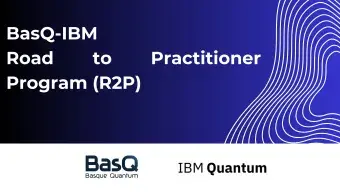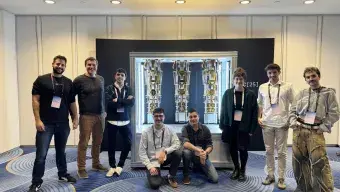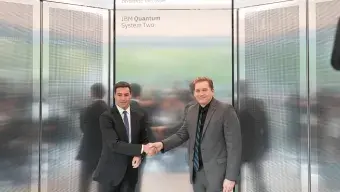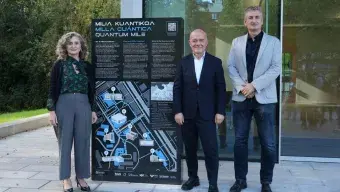IBM Blog: How the Basque Country became a leader in quantum computing
Urria 14, 2025In a few short years, the Basque Country has established itself as a global player in quantum computing. Here’s how.

If you are pursuing a career in quantum technology, there are few places on Earth better suited to your ambitions than the Basque Country.
This is the result of a concerted effort by the Basque government and academia to grow a strong quantum ecosystem, invest in quantum computing, and support researchers interested in the field. Already, this effort is paying dividends. Basque researchers are producing exciting results in high-energy physics, time crystals, and quantum algorithm development, and advancing the field of quantum computing.
The Basque Country, located in the northern region of Spain, numbers only 2.2 million people, but it has long had a robust physics community. The Basque government set up Ikerbasque, the Basque Foundation for Science, in 2007 to support and grow this and the broader scientific community.
Javier Aizpurua, professor at Ikerbasque and now Scientific Director of the Basque Quantum Initiative (BasQ), said that when the government first reached out to him to explore bringing quantum computing to the Basque country, he was strongly supportive.
After a survey of the regional scientific community, “We came to the conclusion that this could be a really key enabling technology, that could help us keep producing excellent science, technology, and innovation,” said Aizpurua. “And in the process we would gain access to one of the most advanced quantum computers in the world… So the Basque government made a strong, institutional bet on quantum computing.”
That bet first took the form of BasQ in 2023. The Department of Science, Universities, and Innovation of the Basque Government and the three Provincial Councils of Araba, Bizkaia and Gipuzkoa lead this initiative, which supports a broad range of quantum research, and provides dedicated access to IBM quantum computers through the IBM-Euskadi Quantum Computational Center.
IBM had made the first quantum computer available to the public just a few years earlier in 2016. IBM broke the 100-qubit barrier for the first time in 2022, and demonstrated utility for the first time in 2023. BasQ put the Basque country in a position to take early advantage of that progress, and in October 2025 unveilied the first IBM Quantum System Two in Europe.
Now that BasQ has an on-premises IBM Quantum System Two, it will benefit from special access to the most advanced quantum computing technology in the world. On October 14, BasQ and IBM inaugurated this installation, powered by a 156-qubit IBM Quantum Heron processor.
Even before that IBM Quantum System Two was unveiled, BasQ-affiliated scientists have been using IBM quantum computers to deliver impressive results. BasQ researchers learn from IBM experts to develop their quantum skills. But the ecosystem there has grown to the point where BasQ researchers increasingly teach and learn from each other, making the Basque Country a hub of homegrown quantum computing expertise.
A new way of modeling subatomic behavior
For one ongoing project, researchers are using IBM quantum computers to help understand the mathematical underpinnings of the strong nuclear force—the same force that holds the nuclei of atoms together.
If you are pursuing a career in quantum technology, there are few places on Earth better suited to your ambitions than the Basque Country.
This is the result of a concerted effort by the Basque government and academia to grow a strong quantum ecosystem, invest in quantum computing, and support researchers interested in the field. Already, this effort is paying dividends. Basque researchers are producing exciting results in high-energy physics, time crystals, and quantum algorithm development, and advancing the field of quantum computing.
The Basque Country, located in the northern region of Spain, numbers only 2.2 million people, but it has long had a robust physics community. The Basque government set up Ikerbasque, the Basque Foundation for Science, in 2007 to support and grow this and the broader scientific community.
Javier Aizpurua, professor at Ikerbasque and now Scientific Director of the Basque Quantum Initiative (BasQ), said that when the government first reached out to him to explore bringing quantum computing to the Basque country, he was strongly supportive.
After a survey of the regional scientific community, “We came to the conclusion that this could be a really key enabling technology, that could help us keep producing excellent science, technology, and innovation,” said Aizpurua. “And in the process we would gain access to one of the most advanced quantum computers in the world… So the Basque government made a strong, institutional bet on quantum computing.”
That bet first took the form of BasQ in 2023. The Department of Science, Universities, and Innovation of the Basque Government and the three Provincial Councils of Araba, Bizkaia and Gipuzkoa lead this initiative, which supports a broad range of quantum research, and provides dedicated access to IBM quantum computers through the IBM-Euskadi Quantum Computational Center.
IBM had made the first quantum computer available to the public just a few years earlier in 2016. IBM broke the 100-qubit barrier for the first time in 2022, and demonstrated utility for the first time in 2023. BasQ put the Basque country in a position to take early advantage of that progress, and in October 2025 unveilied the first IBM Quantum System Two in Europe.
Now that BasQ has an on-premises IBM Quantum System Two, it will benefit from special access to the most advanced quantum computing technology in the world. On October 14, BasQ and IBM inaugurated this installation, powered by a 156-qubit IBM Quantum Heron processor.
Even before that IBM Quantum System Two was unveiled, BasQ-affiliated scientists have been using IBM quantum computers to deliver impressive results. BasQ researchers learn from IBM experts to develop their quantum skills. But the ecosystem there has grown to the point where BasQ researchers increasingly teach and learn from each other, making the Basque Country a hub of homegrown quantum computing expertise.
A new way of modeling subatomic behavior
For one ongoing project, researchers are using IBM quantum computers to help understand the mathematical underpinnings of the strong nuclear force—the same force that holds the nuclei of atoms together.
Strong force interactions are difficult to model or directly study. We mostly understand this force as the “glue” holding together subunits of protons and neutrons, called quarks. The strong force interacts in complex ways according to the rules of quantum chromodynamics. However, even simplified models of this force quickly reach scales that are too complex for classical supercomputers to handle. Today, the best method for studying strong force interactions remains particle colliders—vast, expensive experimental machines that ram protons together over and over, with the aim of collecting data on the particles, energies, and trajectories produced in high-energy collisions.
“The big question is, can we mimic the physics that happens in these colliders in a table top experiment?” said Enrique Rico, a physicist affiliated with both CERN and BasQ who has been a leader in this work. “Because although these quantum machines are big, compared to 20-kilometer colliders they are tabletop experiments.”
The joint BasQ-IBM research team, with members also from Ikerbasque, DIPC, EHU QC, CERN, IFT UAM–CSIC, Wigner RCP, and TUM, has made progress in simulating aspects of the strong force on a quantum computer. In as-yet unpublished work, they modeled simplified quarks moving back and forth, bending, oscillating, and spreading across the lattice of an IBM Quantum Heron chip.
Long-term access to real quantum hardware through the BasQ-IBM partnership made this work possible.
BasQ researchers spend significant time using IBM quantum computers and collaborating with IBM researchers and other academic partners of the IBM-Euskadi Quantum Computational Center to develop their quantum skills.
Jesús Cobos Jiménez, a PhD student at the University of the Basque Country who has played a key role in this quark modeling effort, said that the collaboration with IBM experts prepared him and his colleagues to do effective work on real quantum hardware.
“I think there's a tendency when people first try quantum computing to say, ‘OK, I’ll do everything using classical simulators. I don't need to touch the quantum hardware until I go for my final results.’” said Joana Fraxanet Morales, an IBM Quantum Algorithm Enigneer who works closely with BasQ researchers. “But I think it's important to realize that there's a big gap between simulating things on your laptop and then actually starting to use the quantum hardware. We do a good job at IBM with the learning platform, teaching people techniques. But there’s a part you only get with practice.”
A rising generation of Basque quantum experts
As quantum computers advance, Lorente said he’s hoping to use them to study spin liquids, which involve complex fluctuations and long-range interactions that are even more difficult to model than time crystals. He’s also hopeful that IBM Quantum Nighthawk will offer new opportunities for modeling condensed matter physics due to its increased connectivity. BasQ’s commitment to quantum computing means that more of this effort will take place in the Basque Country, on Basque-located quantum resources.
Cobos said quantum computing is a tool for advancing science, and that his work on the quark simulations has not only built his quantum skills but also made him a better collaborator—learning to get researchers across a wide range of domains working together effectively as a team.
Fraxanet Morales said she has seen rapid skill development among students and researchers in the Basque Country thanks to BasQ. She pointed in particular to the BasQ Advocates, individuals who have taken it upon themselves to support the growth and adoption of quantum technology in the Basque Country.
“People here are becoming experts,” she said. “Not only are they doing the work on many of the things that are being published, but they’re teaching their community. They are organizing workshops. They are getting other people to start using these computers. It’s quite nice.”
Those workshops, Cobos said, offer a “relaxed environment” for collaborating, learning, and developing quantum skills.
Consistency is key to growing an ecosystem like this, Aizpurua said. The Basque government’s consistent, committed support has enabled the Basque quantum ecosystem to grow.
Now, he said, there is a rising generation of BasQ-trained researchers and PhD students with quantum skills, ready to drive Basque quantum research for decades into the future.




